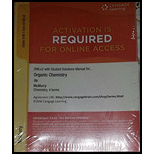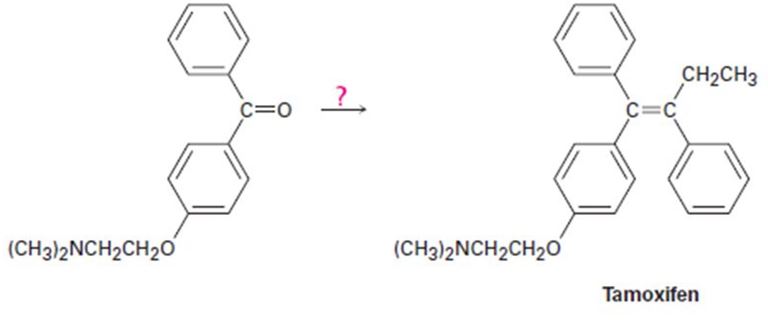
OWLv2 with Student Solutions Manual eBook, 4 terms (24 months) Printed Access Card for McMurry's Organic Chemistry, 9th
9th Edition
ISBN: 9781305671874
Author: John E. McMurry
Publisher: Cengage Learning
expand_more
expand_more
format_list_bulleted
Concept explainers
Textbook Question
Chapter 19.SE, Problem 78AP
Tamoxifen is a drug used in the treatment of breast cancer. How would you prepare tamoxifen from benzene, the following

Expert Solution & Answer
Trending nowThis is a popular solution!

Students have asked these similar questions
Please predict the products for each of the
following reactions.
Clearly show the regiochemistry (Markovnikov
vs anti-Markovnikov) and stereochemistry
(syn- vs anti- or both).
If a mixture of enantiomers is formed, please
draw all the enantiomers.
Hint: In this case you must choose the best
answer to demonstrate the stereochemistry of
H2 addition.
1.03
2. (CH3)2S
BIZ
CH₂OH
2. DMS
KMnO4, NaOH
ΖΗ
Pd or Pt (catalyst)
HBr
20 1
HBr
ROOR (peroxide)
HO
H-SO
HC
12 11 10
BH, THE
2. H2O2, NaOH
Brz
cold
HI
19
18
17
16
MCPBA
15
14
13
A
Br
H₂O
BH3⚫THF
Brz
EtOH
Pd or Ni (catalyst)
D₂ (deuterium)
1. Os04
2. H2O2
CH3CO3H
(peroxyacid)
1. MCPBA
2. H₂O*
H
B
+
H
H
H
"H
C
H
H
D
Explain how Beer’s Law can be used to determine the concentration in a selected food sample. Provide examples.
Explain the importance of having a sampling plan with respect to food analysis.
Explain the importance of having a sampling plan with respect to food analysis. Provide examples.
Chapter 19 Solutions
OWLv2 with Student Solutions Manual eBook, 4 terms (24 months) Printed Access Card for McMurry's Organic Chemistry, 9th
Ch. 19.1 - Prob. 1PCh. 19.1 - Draw structures corresponding to the following...Ch. 19.2 - Prob. 3PCh. 19.2 - How would you carry out the following reactions?...Ch. 19.4 - Treatment of an aldehyde or ketone with cyanide...Ch. 19.4 - p-Nitrobenzaldehyde is more reactive toward...Ch. 19.5 - Prob. 7PCh. 19.5 - The oxygen in water is primarily (99.8) 16O, but...Ch. 19.6 - Prob. 9PCh. 19.8 - Show the products you would obtain by...
Ch. 19.8 - Prob. 11PCh. 19.8 - Prob. 12PCh. 19.9 - Prob. 13PCh. 19.10 - Prob. 14PCh. 19.10 - Prob. 15PCh. 19.11 - What carbonyl compound and what phosphorus ylide...Ch. 19.11 - -Carotene, a yellow food-coloring agent and...Ch. 19.12 - Prob. 18PCh. 19.12 - Prob. 19PCh. 19.13 - Prob. 20PCh. 19.13 - Treatment of 2-cyclohexenone with HCN/KCN yields a...Ch. 19.13 - How might conjugate addition reactions of lithium...Ch. 19.14 - How might you use IR spectroscopy to determine...Ch. 19.14 - Prob. 24PCh. 19.14 - Prob. 25PCh. 19.14 - Prob. 26PCh. 19.SE - Each of the following substances can be prepared...Ch. 19.SE - Prob. 28VCCh. 19.SE - Prob. 29VCCh. 19.SE - Prob. 30MPCh. 19.SE - Prob. 31MPCh. 19.SE - Prob. 32MPCh. 19.SE - Prob. 33MPCh. 19.SE - Prob. 34MPCh. 19.SE - Prob. 35MPCh. 19.SE - It is not uncommon for organic chemists to prepare...Ch. 19.SE - Prob. 37MPCh. 19.SE - Prob. 38MPCh. 19.SE - Prob. 39MPCh. 19.SE - Prob. 40MPCh. 19.SE - Aldehydes and ketones react with thiols to yield...Ch. 19.SE - Prob. 42MPCh. 19.SE - When cyclohexanone is heated in the presence of a...Ch. 19.SE - Prob. 44MPCh. 19.SE - The Meerwein-Ponndorf-Verley reaction involves...Ch. 19.SE - Propose a mechanism to account for the formation...Ch. 19.SE - Prob. 47MPCh. 19.SE - Prob. 48MPCh. 19.SE - Treatment of an , -unsaturated ketone with basic...Ch. 19.SE - Prob. 50MPCh. 19.SE - Prob. 51MPCh. 19.SE - Prob. 52MPCh. 19.SE - Prob. 53MPCh. 19.SE - Prob. 54APCh. 19.SE - Draw and name the seven aldehydes and ketones with...Ch. 19.SE - Give IUPAC names for the following compounds:Ch. 19.SE - Draw structures of compounds that fit the...Ch. 19.SE - Predict the products of the reaction of (1)...Ch. 19.SE - Show how you might use a Wittig reaction to...Ch. 19.SE - How would you use a Grignard reaction on an...Ch. 19.SE - Prob. 61APCh. 19.SE - Prob. 62APCh. 19.SE - How would you synthesize the following substances...Ch. 19.SE - Carvone is the major constituent of spearmint oil....Ch. 19.SE - How would you synthesize the following compounds...Ch. 19.SE - At what position would you expect to observe IR...Ch. 19.SE - Acidcatalyzed dehydration of...Ch. 19.SE - Choose the structure that best fits the IR...Ch. 19.SE - Propose structures for molecules that meet the...Ch. 19.SE - Prob. 70APCh. 19.SE - Prob. 71APCh. 19.SE - When 4hydroxybutanal is treated with methanol in...Ch. 19.SE - Prob. 73APCh. 19.SE - Prob. 74APCh. 19.SE - Prob. 75APCh. 19.SE - Prob. 76APCh. 19.SE - Prob. 77APCh. 19.SE - Tamoxifen is a drug used in the treatment of...Ch. 19.SE - Compound A, MW 86, shows an IR absorption at 1730...Ch. 19.SE - Compound B is isomeric with A (Problem 19-79) and...Ch. 19.SE - The 1HNMR spectrum shown is that of a compound...Ch. 19.SE - Prob. 82APCh. 19.SE - Propose structures for ketones or aldehydes that...Ch. 19.SE - Prob. 84APCh. 19.SE - Prob. 85APCh. 19.SE - The proton and carbon NMR spectra for each of...Ch. 19.SE - The proton NMR spectrum for a compound with...
Knowledge Booster
Learn more about
Need a deep-dive on the concept behind this application? Look no further. Learn more about this topic, chemistry and related others by exploring similar questions and additional content below.Similar questions
- Please predict the products for each of the following reactions. Clearly show the regiochemistry (Markovnikov vs anti-Markovnikov) and stereochemistry (syn- vs anti- or both). If a mixture of enantiomers is formed, please draw all the enantiomers. cold KMnO4, NaOH 2. DMS 1. 03 CH3OH Br2 1. 03 2. (CH3)2S H₂ Pd or Pt (catalyst) HBr 18 19 20 1 HBr ROOR (peroxide) H₂O H₂SO4 HCI HI 17 16 6 15 MCPBA 1. BH3 THF 2. H₂O2, NaOH 1. OsO4 2. H₂O₂ 110 CH3CO₂H (peroxyacid) 1. MCPBA 2. H₂O* Br2 H₂O BH3 THF B12 EtOH Pd or Ni (catalyst) D₂ (deuterium) Bra A B C D H OH H OH OH H OH α α α OH H OH OH фон d H "Harrow_forwardBriefly indicate the models that describe the structure of the interface: Helmholtz-Perrin, Gouy-Chapman, Stern and Grahame models.arrow_forwardElectrochemistry. Briefly describe the Gibbs model and the Gibbs absorption equation.arrow_forward
- Briefly state the electrocapillary equation for ideally polarized electrodes.arrow_forwardWhat is surface excess according to the Gibbs model?arrow_forwardUsing Benzene as starting materid show how each of the Following molecules Contel Ve syntheswed CHI 9. b -50311 с CHY 503H Ночто d. อ •NOV e 11-0-650 NO2arrow_forward
- The molecule PYRIDINE, 6th electrons and is therefore aromatre and is Assigned the Following structure contering Since aromatk moleculoy undergo electrophilic anomatic substitution, Pyridine shodd undergo The Following reaction + HNO3 12504 a. write all of the possible Mononitration Products that could Result From this reaction 18. Bared upon the reaction mechanison determime which of these producty would be the major Product of the hegetionarrow_forwarda. Explain Why electron withdrawing groups tend to be meta-Directors. Your answer Should lyclude all apropriate. Resonance contributing Structures fo. Explain why -ll is an outho -tura drccton even though chlorine has a very High Electronegativityarrow_forward9. Write Me product as well as the reaction Mechanism For each of the Following Vanctions +H₂504 4.50+ T C. +212 Fellz 237 b. Praw the potential energy Diagrams For each OF Mese Rauctions and account For any differences that appear in the two potential Puergy Diagrams which of here two reactions 19 Found to be Reversable, Rationalice your answer based upon the venation mechanisms and the potential energy diagrams.arrow_forward
arrow_back_ios
SEE MORE QUESTIONS
arrow_forward_ios
Recommended textbooks for you
 Introduction to General, Organic and BiochemistryChemistryISBN:9781285869759Author:Frederick A. Bettelheim, William H. Brown, Mary K. Campbell, Shawn O. Farrell, Omar TorresPublisher:Cengage Learning
Introduction to General, Organic and BiochemistryChemistryISBN:9781285869759Author:Frederick A. Bettelheim, William H. Brown, Mary K. Campbell, Shawn O. Farrell, Omar TorresPublisher:Cengage Learning Organic ChemistryChemistryISBN:9781305580350Author:William H. Brown, Brent L. Iverson, Eric Anslyn, Christopher S. FootePublisher:Cengage Learning
Organic ChemistryChemistryISBN:9781305580350Author:William H. Brown, Brent L. Iverson, Eric Anslyn, Christopher S. FootePublisher:Cengage Learning

Introduction to General, Organic and Biochemistry
Chemistry
ISBN:9781285869759
Author:Frederick A. Bettelheim, William H. Brown, Mary K. Campbell, Shawn O. Farrell, Omar Torres
Publisher:Cengage Learning

Organic Chemistry
Chemistry
ISBN:9781305580350
Author:William H. Brown, Brent L. Iverson, Eric Anslyn, Christopher S. Foote
Publisher:Cengage Learning
How to Design a Total Synthesis; Author: Chemistry Unleashed;https://www.youtube.com/watch?v=9jRfAJJO7mM;License: Standard YouTube License, CC-BY